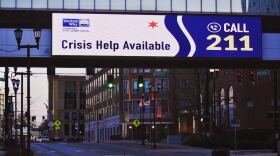The elderly are especially vulnerable to COVID-19. The country’s first big outbreak was at a nursing home in Washington state, and more recently nursing homes and senior living facilities in places like Indiana, Illinois and Iowa have had experienced dozens of cases -- and deaths. Now, these places are facing a lot of pressure to keep residents safe -- and occupied.
When COVID-19 cases were first reported in Iowa last month, Oaknoll Retirement Residence in Iowa City immediately made changes to protect its 380 residents.
"So we limited our access to the building to three different entrances. And we've been staffing those entrances for about 12, 16 hours a day," says Oaknoll administrator Kim Bergen-Jackson.
But she still worries constantly about a COVID-19 outbreak.
"You’re terrified. Essentially, you're holding your breath waiting until -- if it comes to your place, you know, you're doing everything you can to fight something that you can't see," she says.
Because nursing homes and senior living facilities are particularly vulnerable to viral outbreaks, state and federal agencies directed them last month to take strict measures. This means no visitors and all staff must be screened for symptoms daily.
But even the strictest precautions aren’t guaranteed to work. Nursing homes and senior living facilities across the country have reported COVID-19 cases in residents and staff. And the virus often spreads rapidly.
"A lot of sleep gets lost, praying that nothing comes into our building," says Sylvia Barlow, who manages Manilla Manor, a facility in in rural western Iowa with 32 residents.
In addition to the government restrictions, her facility makes sure residents practice social distancing. This means limiting the number of people who can sit together at times.
That’s been hard on residents. "When we, you know, pulled different ones away from the table and put them to a different table, then they're upset because they're not with the regular table partners," Barlow says.
The restrictions that are necessary for seniors can create their own health problems.
"People...might have cognitive difficulties or really not have a whole lot of physical function, and then just basically confining them to their rooms and not really be able to walk around and have social activity," says Michael Barnett, a professor of health policy and management at Harvard.
That’s why it’s important to make sure residents can regularly contact family. "That's gonna be really one of the only things that's going to help ground them in this really scary new reality," he says.
Ryan Stuck, the executive director of Kennybrook Village in suburban Des Moines, says they made adjustments right away to keep their 110 residents connected.
"We went out and purchased new iPads for the purpose of doing FaceTime as much as we can, and Skype with family members," he says. They also play bingo with just one resident at each table, have small group movie screenings and make root beer float deliveries.
Betsy Boyd’s 93-year-old father, Sandy, is at Oaknoll in Iowa City.
"My father and mother would have dinner every night at Oaknoll in his room. And so obviously, that's been a change, that they can no longer do that," Boyd says.
But Boyd says staff members have helped her father use FaceTime and she regularly drops off books. "He is just a voracious reader, and that's how he's coping."
For her father’s 93rd birthday, they threw a virtual family party using the video conferencing program Zoom. 24 people joined in — including a relative stationed in Okinawa with the Marines.
Boyd says even though it is tough, the family prefers her father is staying inside, away from the virus as much as possible.
This story was produced by Side Effects Public Media, a news collaborative covering public health.








